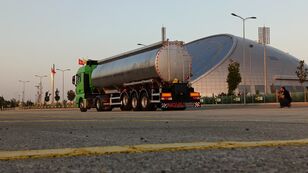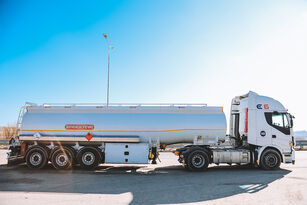New Janco/GP Lift zabudowa asenizacyjna 28 m³ vacuum semi-trailer





















≈ UGX 187,700,000
If you decide to buy equipment at a low price, make sure that you communicate with the real seller. Find out as much information about the owner of the equipment as possible. One way of cheating is to represent yourself as a real company. In case of suspicion, inform us about this for additional control, through the feedback form.
Before you decide to make a purchase, carefully review several sales offers to understand the average cost of your chosen equipment. If the price of the offer you like is much lower than similar offers, think about it. A significant price difference may indicate hidden defects or an attempt by the seller to commit fraudulent acts.
Do not buy products which price is too different from the average price for similar equipment.
Do not give consent to dubious pledges and prepaid goods. In case of doubt, do not be afraid to clarify details, ask for additional photographs and documents for equipment, check the authenticity of documents, ask questions.
The most common type of fraud. Unfair sellers may request a certain amount of advance payment to “book” your right to purchase equipment. Thus, fraudsters can collect a large amount and disappear, no longer get in touch.
- Transfer of prepayment to the card
- Do not make an advance payment without paperwork confirming the process of transferring money, if during the communication the seller is in doubt.
- Transfer to the “Trustee” account
- Such a request should be alarming, most likely you are communicating with a fraudster.
- Transfer to a company account with a similar name
- Be careful, fraudsters may disguise themselves as well-known companies, making minor changes to the name. Do not transfer funds if the company name is in doubt.
- Substitution of own details in the invoice of a real company
- Before making a transfer, make sure that the specified details are correct, and whether they relate to the specified company.
Seller's contacts

 Poland
Poland 




























































1. Fabrycznie nowa cysterna asenizacyjna o pojemności: 28000 litrów
2. Zbiornik cylindryczny zamontowany na ramie hakowej, wykonany z blachy stalowej grubości 5 mm, wzmocniony pierścieniami zewnętrznymi
3. Nachylenie zbiornika: 4-5 stopni
4. Zbiornik wyposażony w 4 przegrody wewnętrzne
5. Kompresor ssąco–tłoczący z napędem hydraulicznym, wyposażony w zawór nadciśnienia i podciśnienia
6. Głębokość zasysania: ok. 8 metrów od poziomu jezdni
7. Czas napełnienia zbiornika: 25 minut
8. Wąż ssąco–tłoczący fi 110 o długości 20 m
9. Tylna dennica otwierana i ryglowana ręcznie wyposażona w przyłącze strażackie fi 110 oraz zasuwę wyposażoną w zawór odpowietrzający
10. Rynny na węże wykonane z blachy aluminiowej o grubości 3 mm z zaworkami spustowymi o długości odpowiedniej do konstrukcji zbiornika
11. Górny zawór pływakowy znajdujący się wewnątrz zbiornika z podwójnymi kulami, dolny zawór pływakowy znajdujący się pod kompresorem
12. Płynowskaz w przedniej części zbiornika wykonany z poliwęglanu, wyskalowany
13. Manowakuometr
14. Wychwytywacz oleju smarującego
15. Tłumik hałasu
16. Dodatkowe sterowanie kompresora umiejscowione w tylnej części zabudowy
17. Kompresor wyposażony w kroplomierz do regulacji smarowania
18. Obsługa beczki przez jedna osobę – ergonomiczna
19. Maksymalne ciśnienie robocze: 0,5 bar
20. Maksymalne podciśnienie: 0,8 bar
21. Przeniesienie napędu z podwozia poprzez przystawkę odbioru mocy o przełożeniu 1:1
22. Lampa typu „kogut” z tylnej części zbiornika oraz lampa typu halogen do oświetlenia miejsca pracy